Address
304 North Cardinal St.
Dorchester Center, MA 02124
Work Hours
Monday to Friday: 7AM - 7PM
Weekend: 10AM - 5PM
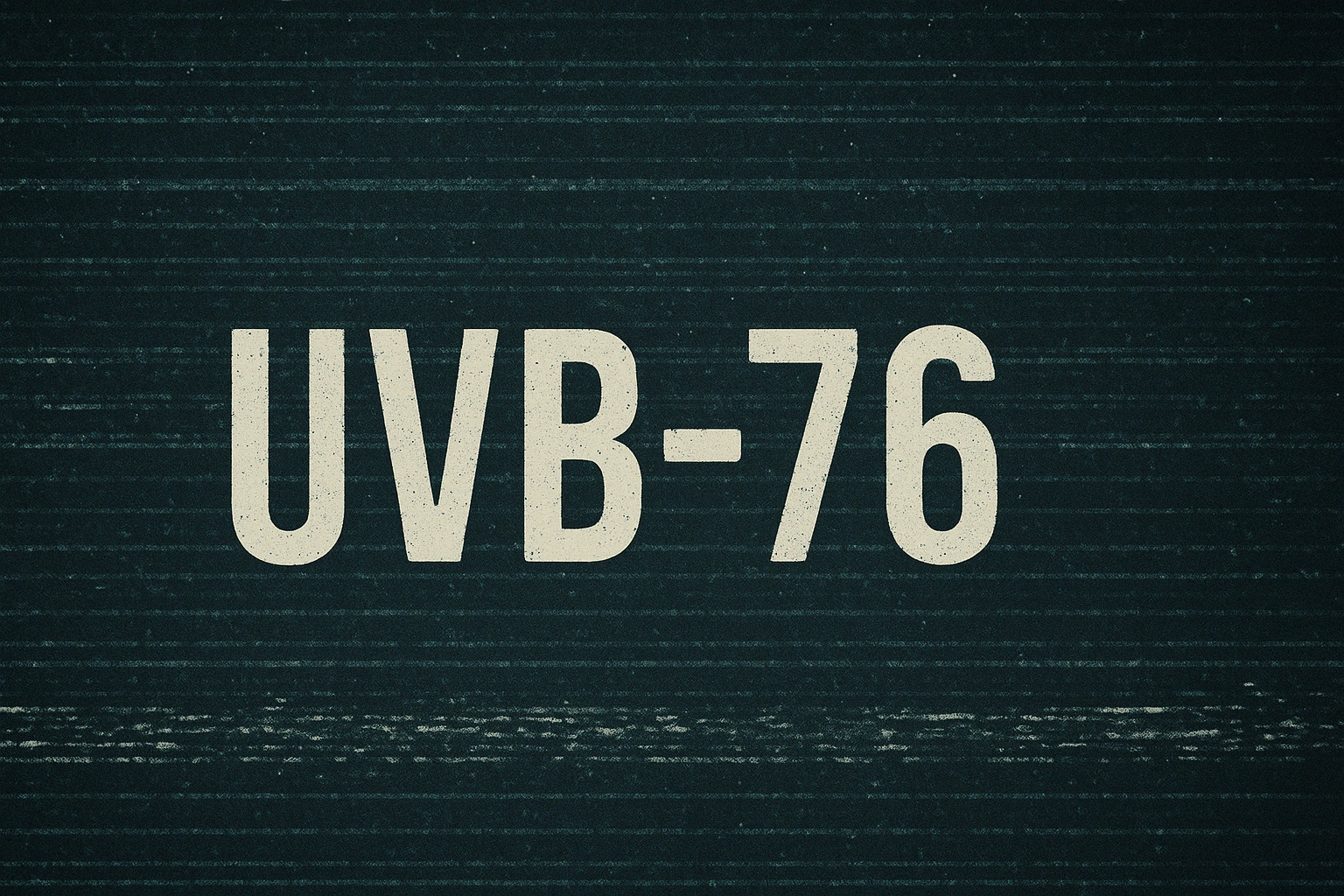
On April 14th, 2025, the Russian shortwave radio station known as UVB-76—nicknamed The Buzzer—broadcast four short words into the void:
Neptune.
Thymus.
Foxcloak.
Nootabu.
For most of its fifty-year lifespan, UVB-76 has produced little more than an audible buzz—a droning, low-frequency tone that’s existed in the background of global communications since the Cold War. It occasionally sputters into speech, but those transmissions are rare, cryptic, and frustratingly contextless. They consist of number sequences, Russian names, or strange word pairings that resist all attempts at coherent translation. There is no known cipher, no public confirmation of its purpose, and no real expectation that anyone outside the Russian military ecosystem is meant to understand them.
And yet, when the station speaks, the world listens.
From Reddit threads to SIGINT monitoring hubs, UVB-76 has evolved into a kind of geopolitical Rorschach test. Analysts and hobbyists pore over its irregularities, tying message bursts to ground invasions, nuclear alerts, intelligence scandals, cyberattacks, or none of the above. The temptation to find meaning—any meaning—is persistent. And maybe that’s the point.
At Prime Rogue Inc., we reject both of the extreme positions:
Instead, we begin with a strategic framing:
The message is probably meaningless. The broadcast is not.
There is a very high probability—north of 90%—that the words “Neptune,” “Thymus,” “Foxcloak,” and “Nootabu” carry no semantic value outside a predefined internal protocol. They may be signal validation packets. They may be redundancy checks for Soviet-era infrastructure. They may be ceremonial—ritual signals of system continuity. Or they may be empty by design, inserted precisely because they tempt interpretation. In intelligence, misdirection is as valuable as truth.
Still, UVB-76 broadcasts do not happen randomly. They have clustered during times of military friction, political uncertainty, and global instability. In that sense, they become contextual signals, even when the words mean nothing at all.
This report does not aim to “crack” the code. That’s a fool’s errand.
What we offer is something more useful:
When the Buzzer speaks, it doesn’t say much.
But the real message may be in the fact that it’s saying anything at all.
Before diving into any interpretation of UVB-76’s recent messages, we must establish the foundation clearly: we do not know what the messages mean, and we likely never will.
There is no decryption key. No whistleblower has stepped forward to confirm the system’s function. Russian military doctrine does not publicly acknowledge UVB-76. What we have is a frequency, a buzz, and a sporadic pattern of words with no shared syntax or obvious internal logic. To treat the words themselves as inherently meaningful is to misframe the question.
At Prime Rogue Inc., we approach UVB-76 not as a puzzle to be solved but as a signal environment to be profiled. What matters is not what the messages “say”—it’s when they’re sent, how often, in what sequence, and against what backdrop of geopolitical movement.
In that context, our interpretations are speculative by design but disciplined in method.
We assume the following until proven otherwise:
These probabilities are not static. They will be adjusted dynamically in light of ongoing broadcasts, Russian force posture, cyber activity, and political realignments.
We apply four main analytical tools to this brief:
To reiterate: this report does not claim to understand the purpose of the words themselves.
It is a threat-environment brief, not a decoding manual.
Our goal is to profile the signal ecosystem that produces UVB-76 and the geopolitical logic of a country that has kept it alive for fifty years.
UVB-76, sometimes identified by its callsign MDZhB, is one of the longest-running unresolved oddities in modern signals intelligence. Its broadcast history spans nearly five decades, yet its function remains speculative. Like a Cold War ghost stuck in a digital age, it continues to send out its low-frequency buzz and rare voice messages, unchanged by time, regime, or technology.
The public calls it The Buzzer. Intelligence communities call it a persistent unknown. The Russians don’t call it anything at all.
The station was first detected in the late 1970s, believed to be broadcasting out of the Povarovo military installation, north of Moscow. Its format has remained largely consistent:
In the 2010s, the original transmission site was abandoned, and new relay towers appeared elsewhere, notably near St. Petersburg and other military-linked locations. Despite modernization across the Russian military communications apparatus, UVB-76 has persisted unchanged, like a fossil sealed in amber.
Throughout its history, spikes in UVB-76’s activity have often coincided with regional instability, mobilization, or armed conflict:
None of these correlations are definitive. UVB-76 has also remained active during years of relative calm. But the station’s bursts appear to cluster around moments of institutional stress or military mobilization, suggesting it may serve some kind of confirmation, coordination, or continuity function within a closed communication loop.
1. Communications Heartbeat
A widespread theory is that UVB-76 simply acts as a “heartbeat” signal: an ongoing tone to ensure a particular communications channel remains active and monitored. The rare messages may be periodic check-ins or role-call tests for remote military units.
2. Signal Path Validator
Some believe UVB-76 is used to verify the integrity of specific encrypted channels, relays, or passive listening posts. Voice messages might act as authentication packets, ensuring that the network remains viable in a disrupted command environment.
3. Legacy Fail-Deadly Infrastructure
A popular but unverifiable theory links UVB-76 to Russia’s so-called “Dead Hand” or Perimeter system—a Cold War-era automated nuclear retaliation protocol. In this view, the Buzzer exists as part of a “fail-deadly” signal web: if the buzz stops, someone, somewhere might assume command authority has collapsed.
⚠️ This is speculative and unconfirmed. No open-source proof links UVB-76 to active nuclear C2 architecture.
4. Institutional Inertia or PsyOps Theater
The final theory? It no longer serves any core operational purpose—but remains active because:
UVB-76 is not interactive. It does not respond. It does not explain. It simply exists—emitting tone, occasionally barking out strange phrases, and refusing to die.
Its persistence matters more than its meaning.
The broadcast is the performance.
The buzz is the message.
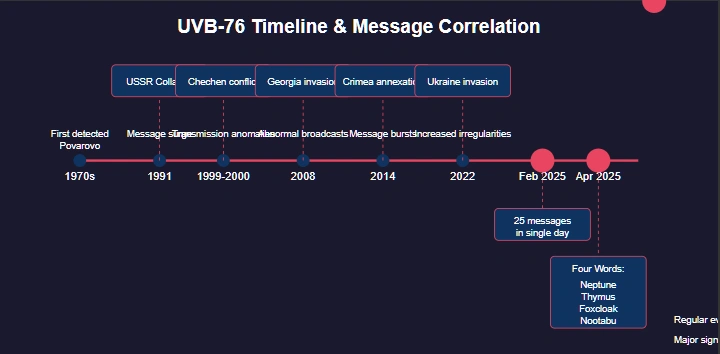
On April 14th, 2025, UVB-76 issued four voice transmissions in close succession—something that has only happened a handful of times in its history. Each consisted of a single word:
This sudden burst came just weeks after a spike in transmissions during February, when the station broadcast 25 short coded messages in a single 24-hour period. That event alone caught the attention of OSINT trackers and legacy SIGINT outfits alike. But the April cluster was different. It wasn’t a flood of number strings or call signs. It was four solitary, evocative, oddly structured words—sent with enough spacing to feel intentional.
And that’s where the risk lies: it feels like something.
But that does not make it something.
This section breaks each word down, not to decode its hidden meaning, but to assess what it could plausibly represent, why it likely doesn’t, and what patterns—semantic, doctrinal, or symbolic—may have led to its selection. Each includes a final probability breakdown.
Surface Associations:
Contextual Triggers (April 2025):
Plausible Readings:
What It’s Not Likely To Be:
Probability Breakdown:
Surface Associations:
Contextual Triggers (April 2025):
Plausible Readings:
What It’s Not Likely To Be:
Probability Breakdown:
Surface Associations:
Contextual Triggers (April 2025):
Plausible Readings:
What It’s Not Likely To Be:
Probability Breakdown:
Surface Associations:
Contextual Triggers (April 2025):
Plausible Readings:
What It’s Not Likely To Be:
Probability Breakdown:

If the most likely scenario is that UVB-76’s messages mean nothing, then why does the station persist?
Why would a modern military with access to satellites, encrypted fiber, laser relays, hardened VLF submariner channels, and secure landline backbones continue pumping out low-frequency static on a Cold War-era shortwave band?
Because in Russian strategic thinking, ambiguity itself has utility. A thing does not need to be “useful” in a Western, efficiency-maximizing sense to retain value within a state built on layered paranoia, defensive reflexes, and deliberate opacity.
UVB-76 does not communicate in the traditional sense.
It occupies space.
And that alone can make it powerful.
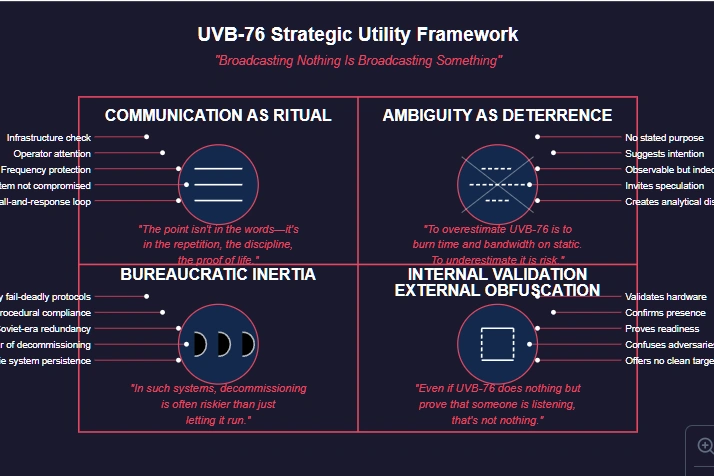
One of the more compelling explanations is that UVB-76 is a form of communications ritual—a persistent tone across a dedicated frequency that ensures:
In this view, the rare voice messages are less about content and more about proving the loop still closes—a call-and-response reflex to satisfy internal readiness protocols or command-chain authentication routines.
Much like religious ritual or organizational ceremony, the point isn’t in the words—it’s in the repetition, the discipline, the proof of life.
UVB-76 is the perfect ambiguous artifact:
Western OSINT forums debate its bursts. NATO SIGINT flags its spikes. Intelligence agencies log its outbursts. But if it doesn’t actually do anything—if it’s just a psychological mirrorball—then it’s achieved a soft deterrent effect at zero cost.
To overestimate UVB-76 is to burn time and analytical bandwidth on static.
To underestimate it is to risk missing a pattern buried in the noise.
That is strategic ambiguity in action.
A less poetic—but no less compelling—explanation is that UVB-76 simply never got shut down.
Much of Russia’s military infrastructure is riddled with redundancies, zombie systems, and layers of overlapping command posts. Soviet-era systems were designed to withstand nuclear decapitation scenarios—not to be tidy.
In this framework:
In such systems, decommissioning is often riskier than just letting it run.
The brilliance of UVB-76—intentional or accidental—is that it functions in two directions:
Even if UVB-76 does nothing but prove that someone is listening, that’s not nothing.
In fact, that may be all it’s meant to do.
When viewed through a narrow lens, UVB-76 is obsolete, bizarre, and pointless.
When viewed through a strategic intelligence lens, it’s something far more durable:
It may not transmit orders.
But it absolutely transmits presence.
The Russian military does not think about information in the same way Western planners do.
In the U.S., military communication doctrine tends to emphasize clarity, redundancy, encryption, and centralized control. Messages are usually either functional or symbolic—not both. Russian doctrine, by contrast, is steeped in reflexive control, a concept that uses misperception as leverage and ambiguity as a weapon.
Under this framework, UVB-76 makes a lot more sense.
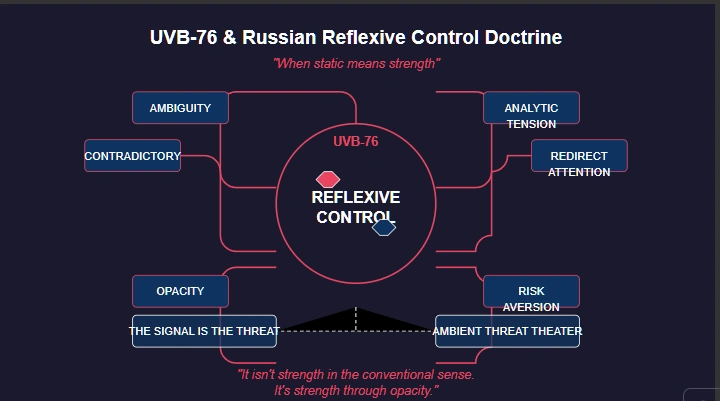
Rather than directly confront an enemy’s moves, you feed them ambiguous or contradictory information that leads them to:
UVB-76 fits neatly into this doctrinal landscape:
UVB-76 does not need to issue real commands. It only needs to be seen as possibly doing so.
In an age of information overload, Russia’s great advantage is that it understands the value of information absence. Western SIGINT analysts are trained to find patterns. UVB-76 offers just enough structure to imply one, but never enough to confirm it.
That creates:
The station becomes an ambient threat, not because it tells Russian forces to act—but because it tells the West they might.
Russia’s defense posture emphasizes survivability and deception. UVB-76 can be interpreted as a redundant channel that now serves a secondary purpose:
It isn’t strength in the conventional sense.
It’s strength through opacity.
By the standards of 2025 C4ISR doctrine, UVB-76 is a dinosaur.
By the standards of Russian psychological operations, it is an active theater.
And because the West can’t ignore it—but can’t decode it either—it sits in a sweet spot:
If UVB-76 cannot be decoded—and if its messages are statistically unlikely to carry literal meaning—then the question becomes: why monitor it at all?
Because the value of UVB-76 isn’t in what it says.
It’s in what it correlates with.
This is a signal environment problem, not a cryptographic one. It demands pattern tracking, temporal analysis, and cross-domain synthesis, not semantic guessing.
The most effective way to monitor UVB-76 is by establishing and maintaining a dynamic behavioral baseline. Track:
UVB-76 should be treated like a cardiac monitor for the Russian strategic signal environment: mostly flatlined, but when it spikes, analysts should cross-check for other abnormalities in the system.
When UVB-76 activity increases, it should be cross-referenced with:
In other words: don’t look at UVB-76 in isolation. Look at it as one blinking light on the dashboard—only meaningful when cross-validated by others.
Too often, analysts waste time trying to “solve” what “Foxcloak” means. The better move is to ask:
The message is the smoke.
But the timing is the fire.
Treat UVB-76 like seismic monitoring equipment.
It won’t tell you why something is happening.
But it might tell you that something is.
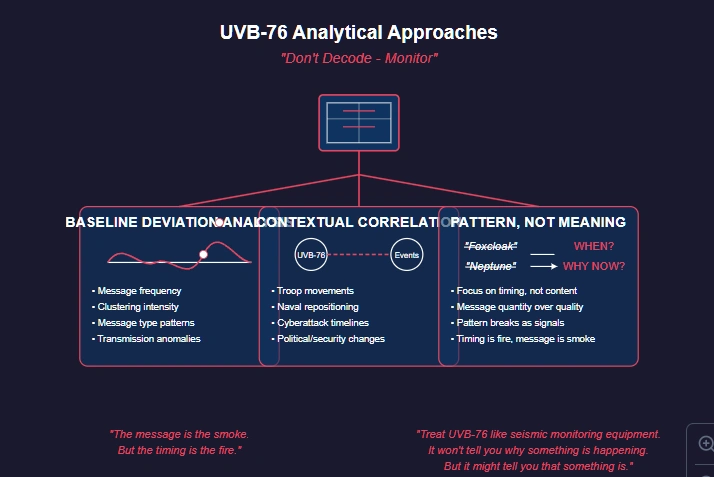
UVB-76 is not a puzzle to be solved. It is a ghost—an artifact of a Cold War machine that may or may not still know why it’s running.
But in its stubborn persistence, in its refusal to offer clarity, UVB-76 does exactly what it needs to do: it demands attention.
The April 2025 burst—Neptune, Thymus, Foxcloak, Nootabu—most likely means nothing in isolation.
There is no operational payload embedded in those words.
There is no hidden code that decrypts them.
And there is certainly no kill switch inside them.
But that doesn’t mean UVB-76 doesn’t matter. It does.
Because it functions as an ambient signal in Russia’s broader doctrine of uncertainty:
It is the theater of threat without the substance of threat—and in a world where decision-makers are overloaded, that is an advantage.
UVB-76 tells us something not about what Russia is doing, but about how Russia wants to be perceived:
In that sense, the Buzzer remains one of the most successful pieces of Cold War infrastructure still in play.
Not because it speaks.
But because we never stopped listening.